 Facebook
Facebook
 X
X
 Instagram
Instagram
 TikTok
TikTok
 Youtube
Youtube
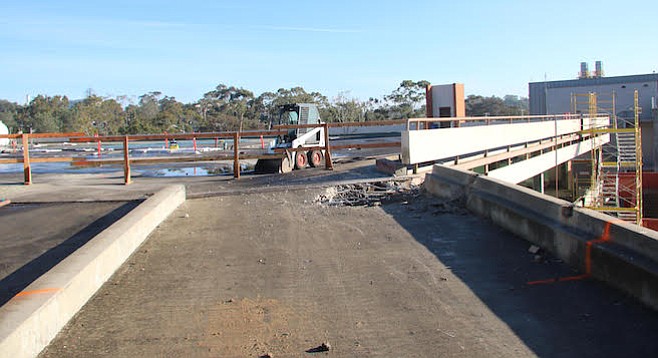
“Part of the project is to remove all of the concrete here and redo it,” said City College project manager Tom Fine last week during a construction-zone tour of the campus. “And I don’t know if you have ever been up here during summer — it’s hot and nobody likes to come here. It's desolate.”
Renovations to the A, D, and T buildings at the college are last among the voter-approved Proposition N projects, an $870 million bond that passed in 2006 to update San Diego Community College District campuses.
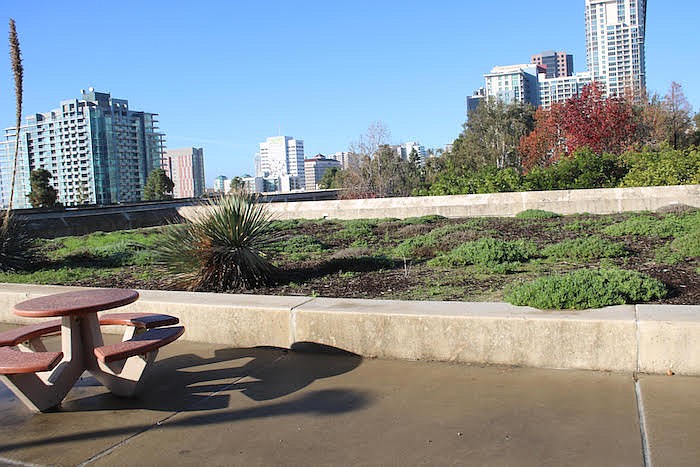
The large rooftop/viewpoint was never given a name on the campus map: it is labeled the “D Building,” a one-story concrete structure with a public-accessible roof, a ground-level open-air courtyard, a cafeteria, and an elevator.
“So the project here is, ‘let’s bring this back to life,’ with raised platforms, seating, canopies, and reinvigorated planters,” Fine said. “This will be a place where people can come to eat and study.”
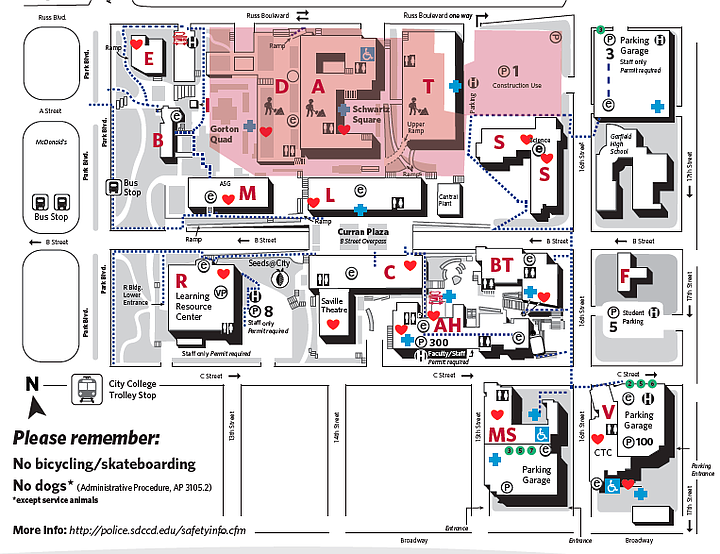
From the rooftop, students and staff have a panoramic view of downtown San Diego buildings and parts of the Coronado bridge.
The views under the roof were not as breathtaking: on some rainy days, the cafeteria ceiling leaked and buckets would be set out to catch the water.
Fine said that aside from redoing the roof drains, a fire-extinguishing sprinkler system and alarm systems will be installed, restrooms will be made more disabled-friendly, and the dining area will get a facelift.
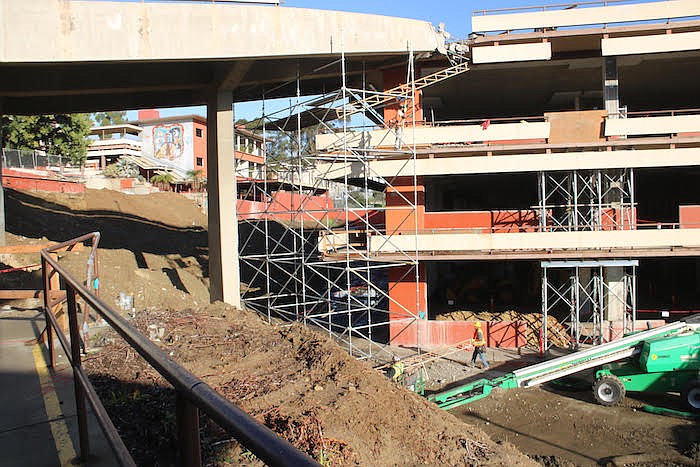
“This is where the leak is,” Fine said, pointing to non-slip steel plates on the concrete between the D and A buildings. “There is a seismic separation here and over the years the leak got worse.”
The school website explains the history of the two other buildings that will get a makeover.
Between 1953 and 1954, the first parcel of land, a single city block between Russ Boulevard and A Street, from 14th to 15th streets, was purchased for the permanent home of what is now San Diego City College. The first buildings constructed were the A and T buildings, which were finished in 1956. Approximately 60 years later, most of the two buildings were demolished.
“About 85 percent of it gets recycled,” Fine said. “Like this concrete, it will get smashed up and made into road base for new roads and streets.”
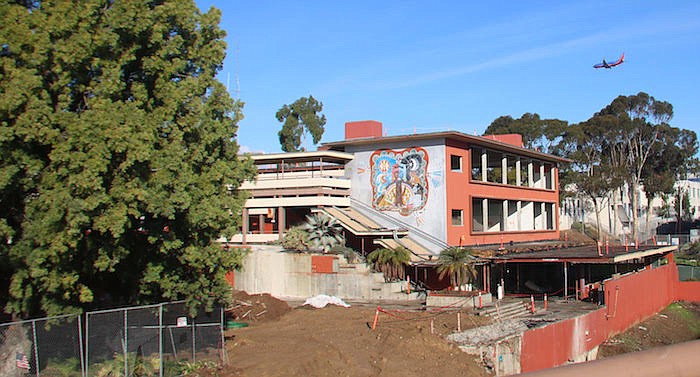
Some of the plaques on the old structure will be reused in the new construction — such as the Schwartz Plaza plaque, which was dedicated to Larry Schwartz, a City College history professor who passed away in 1995. The plaza was an open area in the middle of the A building’s administration and financial-aid offices.
The mural that is painted above the old bookstore and the large pepper tree by the A building will survive the revamp.
The curved bridge that connects to the T building rooftop was partially demolished for the makeover. It was “the first rooftop parking [200 cars] in San Diego,” according to the school's website. It will soon be used for solar arrays and a large greenhouse lab for the campus agriculture and photovoltaic programs.
The Proposition S and N project summary table on the district website states that approximately $64 million was budgeted for the A, D, and T building renovations and that they should be completed by June 2018. A new "Child Development building" is listed to be the next big project on campus.


“Part of the project is to remove all of the concrete here and redo it,” said City College project manager Tom Fine last week during a construction-zone tour of the campus. “And I don’t know if you have ever been up here during summer — it’s hot and nobody likes to come here. It's desolate.”
Renovations to the A, D, and T buildings at the college are last among the voter-approved Proposition N projects, an $870 million bond that passed in 2006 to update San Diego Community College District campuses.

The large rooftop/viewpoint was never given a name on the campus map: it is labeled the “D Building,” a one-story concrete structure with a public-accessible roof, a ground-level open-air courtyard, a cafeteria, and an elevator.
“So the project here is, ‘let’s bring this back to life,’ with raised platforms, seating, canopies, and reinvigorated planters,” Fine said. “This will be a place where people can come to eat and study.”

From the rooftop, students and staff have a panoramic view of downtown San Diego buildings and parts of the Coronado bridge.
The views under the roof were not as breathtaking: on some rainy days, the cafeteria ceiling leaked and buckets would be set out to catch the water.
Fine said that aside from redoing the roof drains, a fire-extinguishing sprinkler system and alarm systems will be installed, restrooms will be made more disabled-friendly, and the dining area will get a facelift.

“This is where the leak is,” Fine said, pointing to non-slip steel plates on the concrete between the D and A buildings. “There is a seismic separation here and over the years the leak got worse.”
The school website explains the history of the two other buildings that will get a makeover.
Between 1953 and 1954, the first parcel of land, a single city block between Russ Boulevard and A Street, from 14th to 15th streets, was purchased for the permanent home of what is now San Diego City College. The first buildings constructed were the A and T buildings, which were finished in 1956. Approximately 60 years later, most of the two buildings were demolished.
“About 85 percent of it gets recycled,” Fine said. “Like this concrete, it will get smashed up and made into road base for new roads and streets.”

Some of the plaques on the old structure will be reused in the new construction — such as the Schwartz Plaza plaque, which was dedicated to Larry Schwartz, a City College history professor who passed away in 1995. The plaza was an open area in the middle of the A building’s administration and financial-aid offices.
The mural that is painted above the old bookstore and the large pepper tree by the A building will survive the revamp.
The curved bridge that connects to the T building rooftop was partially demolished for the makeover. It was “the first rooftop parking [200 cars] in San Diego,” according to the school's website. It will soon be used for solar arrays and a large greenhouse lab for the campus agriculture and photovoltaic programs.
The Proposition S and N project summary table on the district website states that approximately $64 million was budgeted for the A, D, and T building renovations and that they should be completed by June 2018. A new "Child Development building" is listed to be the next big project on campus.
Comments